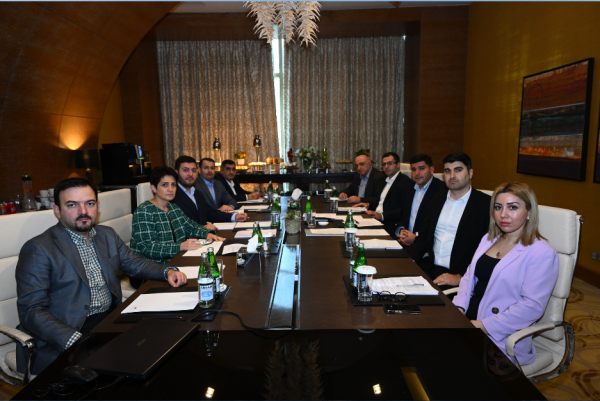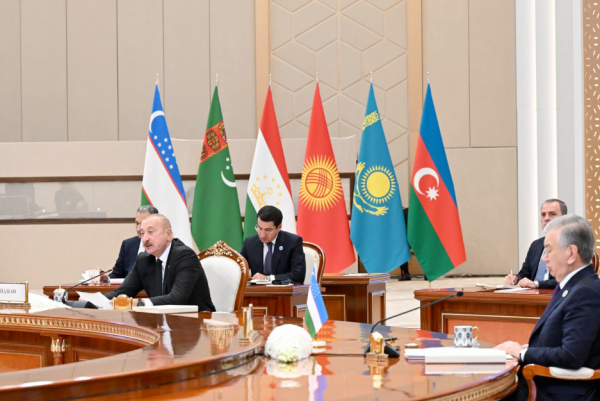From decline to ascent: Europe’s petrochemical crisis and the Caspian opportunity

“ Who controls the Heartland commands the World-Island; who rules the World-Island commands the world. ”
— Halford Mackinder, 1904
In the early 2010s, the European petrochemical industry stood as a global benchmark — technologically sophisticated, environmentally conscious, and commercially competitive. From Antwerp to the Ruhr, European refineries and crackers powered the continent’s industrial base, serving the world with specialty chemicals and high-grade plastics.
But today, that dominance is fading. This decline did not happen overnight. In 2020, the COVID-19 pandemic triggered supply chain paralysis, inflation, and widespread demand destruction. In the same years, massive new integrated petrochemical complexes were ramping up in China, India, and the Middle East — where producers enjoy lower feedstock costs and fewer regulatory burdens. Between 2019 and 2023, global ethylene capacity rose by over 30 million tonnes per year, with nearly 80% of new capacity located outside Europe. By contrast, European cracker utilization fell below 80% in 2023 — a signal of chronic overcapacity and eroding margins.
Then came the final blow: Russia’s invasion of Ukraine in 2022 not only shattered Europe's energy security but also severed its industrial lifelines. The NordStream pipeline was crippled, gas prices soared over €300/MWh by August 2022 — over 10x the pre-crisis norm. As BASF’s CEO bluntly stated: “The fundamentals of the European chemical industry no longer hold.”
Plant closures quickly followed. The Versalis cracker in Italy. Trinseo’s styrenics plant in Germany. SABIC Wilton in the UK. OxyChem exited European PVC. BASF began downsizing in Ludwigshafen — its largest site — cutting over 2,600 jobs. Covestro’s European operations are now reportedly being acquired by ADNOC — a symbolic shift of industrial power toward feedstock-rich, capital-heavy Gulf players.
Last week’s announcement by Dow that it would shut down 3 of its upstream assets in Europe, including its cracker in Boehlen, emphasized the degree of the trouble experienced by the European chemical industry. There have been recent announcements of closures in Europe but this time it is different: Boehlen is not just any cracker complex, it is located in the eastern part of Germany, a structurally weak area and a region dominated politically by the AfD. It was described by Dow as the „Herzstück“ (the “heart”) of the Dow olefin Verbund. In addition, Dow announced the shutdown of its Chlor-alkali & vinyl assets in Schkopau.
According to Dow, “The shutdown of upstream assets in Europe will right-size regional capacity, reduce merchant sale exposure, and remove higher-cost, energy-intensive portions of Dow's portfolio in the region. This will improve our ability to supply profitable derivative demand and optimize margins.” Dow also operates more than 1000km of pipelines connecting Boehlen/region to North Germany (Stade, also up for disposal, and Rostock). The “system effect” becomes apparent, as does the impact on Dow globally. These closures are a body blow to the German/European economy: each highly skilled job in the chemical industry supports a multiple of jobs in supporting services/downstream roles — the ripple effect will be significant, the impact on the region potentially historical.
This decline is happening in parallel with the unseen crisis in Europe’s other economic pillar — its car industry. China's EV boom and cost advantage — with BYD and SAIC — coupled with escalating tariff tensions, threaten legacy manufacturers in Germany and France. The European Commission’s new tariffs on Chinese EVs (up to 38%) risk retaliation. As the war of subsidies and protectionism escalates, the old certainties of global trade are collapsing. In a bigger picture, these processes emphasize probably the most fundamental impact of the Russian aggression against Ukraine — an acceleration of the rate of decrease in Europe’s global importance. Faced with a painful trade-off: reneging on its principles and political commitment to the value-based order, or standing up to Moscow and accepting a severe blow to its economic prosperity, the Old Continent chose the latter.
Yet Europe is not without strength — it still commands the global market in specialty chemicals, high-purity polymers, green chemistry, and circular materials. Companies like Evonik, Clariant, and Solvay lead in innovation. And despite the pain, Europe’s commitment to the green transition is unwavering. No region has more aggressively legislated for carbon neutrality — from CBAM (Carbon Border Adjustment Mechanism), to RED III, to Fit for 55. But that same moral leadership has costs. The renewables push, while principled, has burdened European industry with rising costs and bureaucratic hurdles. Qatar’s refusal to sell long-term LNG to Europe in 2023 over contractual disagreements is one example. Without affordable energy, industrial Europe becomes hollow.
The challenge compounds with every policy misalignment. As China and the U.S. pour billions into AI, quantum computing, semiconductors, and critical materials, Europe lags behind. Despite boasting strong research institutions, Europe has failed to convert knowledge into scaled innovation. In the AI race, Europe is neither ahead in infrastructure, nor in foundational models, nor in commercialization. As Joseph Stiglitz said, "Markets alone cannot create the technologies of tomorrow."
Tariff wars, rising regulatory complexity, and aging infrastructure only deepen the challenge. The Port of Hamburg, once Europe’s gateway to the world, now faces chronic congestion. Antwerp struggles with barge backlogs and hinterland access. German rail, once a symbol of reliability, is now a case study in underinvestment. Meanwhile, global supply chains have grown more brittle. Attacks in the Red Sea, speculations over the Panama Channel by President Trump, recent threat of Hormuz Strait closure and geopolitical flashpoints in the South China Sea all remind us: logistics are no longer neutral. The costs of insuring, financing, and executing a trade route have skyrocketed. Europe, which once benefited from seamless access to raw materials and export markets, now finds itself surrounded by bottlenecks.
At the same time, the labor cost gap is widening. Europe’s aging population, tight labor markets, and strong unions create structural inflexibility. By 2030, over 25% of Europe’s population will be above 65. Compared to Asia or even the United States, Europe’s demographic dividend is expiring. In this context, regionalization becomes a double-edged sword. Localized production might promise resilience, but without structural reform, it merely concentrates inefficiency. Higher input costs, smaller markets, and lower margins will not restore industrial competitiveness. As Machiavelli wrote, "He who is the cause of another becoming powerful is ruined himself."
Europe helped build the global rules-based system. It now finds itself crushed by its own architecture. But is there a place for the Caspian region to find a new place amid the dramatic shake-up of global economic geography?
From ancient times, when the Silk Road first emerged, the Caspian and Central Asian region served as the main artery of East-West trade. In geopolitical theory, this region — Azerbaijan, Georgia, Kazakhstan, Kyrgyzstan, Uzbekistan, Tajikistan, and Turkmenistan — is both Mackinder’s Heartland and Spykman’s Rimland. And as these theories remind us: those who control the Heartland and Rimland control the world.
Azerbaijan, that has been building an incredibly complex, multi-vectored foreign policy, is strategically better prepared for the ongoing dramatic changes of the global scale than most other actors. This strategy takes into account the relative decline of the West, growing entropy of global politics, and the struggle for supply routes and stable energy sources as a new political imperative. The Middle Corridor, a trans-Eurasian project aiming at establishing a secure connection between China and Europe via Central Asia and South Caucasus, is one such example.
Azerbaijan is also making a decisive turn toward renewable energy. Recent projects like the 240 MW Khizi-Absheron wind farm and the 230 MW Garadagh solar plant — in partnership with international players such as Masdar — are part of a broader strategy to generate 30% of domestic power from renewables by 2030. With favorable solar and wind potential, and proximity to major energy corridors, Azerbaijan is positioning itself not just as a fossil energy supplier but also as a future exporter of green electricity and potentially green hydrogen to Europe.
However, to benefit from the petrochemical opportunity, a number of steps should yet be taken. First, trade bottlenecks must be eliminated and borders digitized. Introduction of new terminals, pipelines, and logistics centers must match the speed and ambition of a region claiming its strategic relevance. In oil and gas, there is a need to move downstream, turning feedstock into value-added petrochemicals, resins, and polymers — and this requires multiplying investments in crackers, fertilizers, and plasticizers. In technology, the countries of the region must find ways to reverse brain drain and find efficient channels for homegrown talent. Uzbekistan, Armenia, and Georgia are growing tech hubs — they must be linked, incentivized, and scaled into regional engines of innovation.
Uzbekistan, in particular, is undergoing a profound transformation. Under the “New Uzbekistan 2022–2026” strategy, the country is liberalizing markets, reforming state-owned enterprises, and aggressively expanding its renewable energy base with a target of 8 GW of new capacity by 2030. The government's openness to foreign investment and public-private partnerships is turning Uzbekistan into a rising logistics and manufacturing hub at the heart of Central Asia.
Kazakhstan, too, is accelerating its economic modernization. The country’s “Green Economy Concept” envisions 15% renewable power by 2030 and 50% by 2050. Supported by international capital and a wave of regulatory reforms, Kazakhstan is building large wind and solar farms while also streamlining its investment climate. Its central location along the Middle Corridor makes it a natural bridge between Chinese industry and European consumers, and its efforts in digitization and infrastructure upgrading will be key to its future competitiveness.
All of this is contingent on a robust and sustainable peace in the South Caucasus, which would enable building trust, establishing physical connections crossing the former frontlines, and creating regional value networks. While the world has lost its balance, the Caspian and South Caucasus countries can and should become the axis connecting the fledgling West and ambitious East.
Sources
• European Commission. (2023). EU Emissions Trading System (EU ETS). Retrieved from: https://climate.ec.europa.eu/eu-action/eu-emissions-trading-system-eu-ets_en
• International Energy Agency. (2023). Global ethylene capacity additions 2019–2023. Retrieved from: https://www.iea.org/
• BASF SE. (2023). BASF Annual Report 2022–2023. Retrieved from: https://report.basf.com/
• Financial Times. (2022, August). Europe’s gas prices surpass €300/MWh amid Nord Stream crisis.
• Reuters. (2023). Covestro reportedly in talks with ADNOC over possible acquisition. Retrieved from: https://www.reuters.com/
• Trinseo. (2023). Company Press Releases. Retrieved from: https://www.trinseo.com/News
• Bloomberg. (2023). Qatar refuses to sell long-term LNG to Europe under EU contract terms. Retrieved from: https://www.bloomberg.com/
• European Council. (2023). Carbon Border Adjustment Mechanism (CBAM). Retrieved from: https://www.consilium.europa.eu/
• Eurostat. (2024). EU Demographic Outlook 2023–2030. Retrieved from: https://ec.europa.eu/eurostat/
• Dow. (2024, July). Dow accelerates performance and progress with actions to enhance competitiveness. Retrieved from: https://corporate.dow.com/en-us/news/press-releases/dow-announces-actions-to-enhance-competitiveness-2024.html
• ICIS. (2024, July 18). Dow to close three European assets including Boehlen cracker amid poor demand, weak margins. Retrieved from: https://www.icis.com/explore/resources/news/2024/07/18/10923298/dow-to-close-three-european-assets-including-boehlen-cracker-amid-poor-demand-weak-margins/
• Stiglitz, J. (2006). Making Globalization Work. W.W. Norton & Company.
• Machiavelli, N. (1532). The Prince. Florence.
• Mackinder, H. J. (1904). The Geographical Pivot of History. The Geographical Journal, 23(4), 421–437.
• Spykman, N. J. (1944). The Geography of the Peace. Harcourt, Brace and Company.
• World Economic Forum. (2023). AI Investment and Global Innovation Index. Retrieved from: https://www.weforum.org/
• UNCTAD. (2023). Global Trade Update: Shifting Supply Chains and Rising Trade Barriers. Retrieved from: https://unctad.org/
• Asian Development Bank. (2023). Middle Corridor and the Future of Eurasian Connectivity. Retrieved from: https://www.adb.org/
• International Transport Forum. (2023). Transport Infrastructure in the Caspian and Central Asia. Retrieved from: https://www.itf-oecd.org/
• McKinsey & Company. (2023). Europe’s Industrial Future: Navigating Energy, Innovation, and Talent. Retrieved from: https://www.mckinsey.com/
• Masdar. (2023, October). Masdar signs agreements for 1 GW clean energy projects in Azerbaijan. Retrieved from: https://masdar.ae/en/news/2023/10/05/14/26/masdar-1gw-clean-energy-projects-azerbaijan
• IEA. (2023). Azerbaijan Energy Profile – Analysis. International Energy Agency. Retrieved from: https://www.iea.org/reports/azerbaijan-energy-profile
• ADB. (2022). Uzbekistan 2022–2026 Development Strategy. Asian Development Bank. Retrieved from: https://www.adb.org/news/features/uzbekistan-bold-reforms-modernize-and-diversify-economy
• IEA. (2023). Uzbekistan: Energy Profile. International Energy Agency. Retrieved from: https://www.iea.org/countries/uzbekistan
• IEA. (2023). Kazakhstan Energy Profile. International Energy Agency. Retrieved from: https://www.iea.org/countries/kazakhstan








